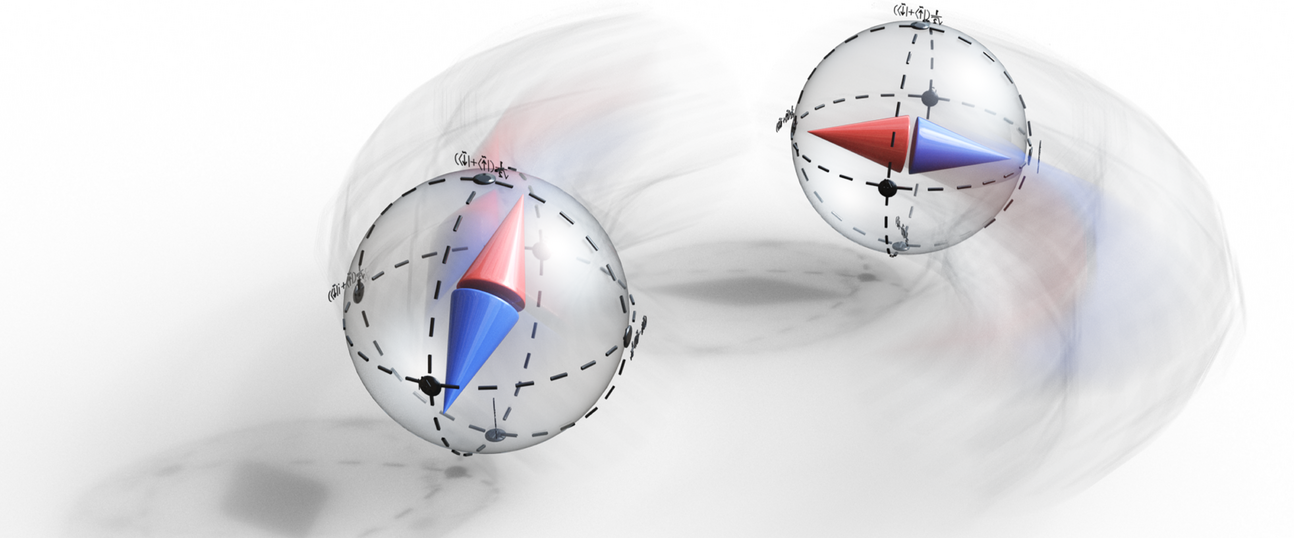In information technology, nonreciprocal devices are of key importance. They let information carriers only move forward and not backward or let them circulate only clockwise and not counterclockwise. In a word, they provide the one-way streets enabling signal routing and suppression of crosstalk. We now observed for the first time nonreciprocal transport of spin information carried by magnons in an antiferromagnetic insulator and even could control it by an applied magnetic field. This discovery provides a new perspective for magnonic devices in information technology.
Today, information is encoded and transported by a variety of different carriers such as electrons, photons or magnons. Whereas photons dominate in communication systems, electrons do so in information processing devices. Besides a charge, electrons also possess a spin as an intrinsic property with two different spin states along a quantization axis. As this allows for binary information encoding, also the spin degree of freedom and its associated magnetic moment are exploited in a steadily growing field of information technology called spintronics. Well-known examples are magnetic random-access memories or magnetic storage systems.
Using electrons for spin transport is not the only choice. In magnetically ordered materials such as ferromagnets or antiferromagnets, spin can be carried by elementary excitations of the spin lattice, called magnons, without any associated charge transport. That is, spin information encoded into magnons can be transported even in electrical insulators. Whereas the magnetic moments associated with the spins prefer a parallel orientation in ferromagnets, the opposite is true for antiferromagnets. Interestingly, the antiparallel arrangement between neighboring moments lets antiferromagnets look “non-magnetic” from the outside, providing not only robustness against external magnetic fields, but also providing faster control. These properties triggered huge interest in antiferromagnetic materials.
Building a one-way street for spin information
A key question regarding the application of antiferromagnets in information technology is how to realize nonreciprocal devices, providing controllable unidirectional flow of spin. To this end, experimentalists at the Walther-Meißner-Institute (WMI) of BAdW and TUM in collaboration with theoreticians at UAM studied magnon-mediated spin transport in devices based on thin films of the antiferromagnetic insulator hematite. As spin information is only carried by magnons and any charge transport is absent, such devices are of particular interest for applications aiming at the reduction of power dissipation associated with charge transport. Most importantly, the scientists discovered a nonreciprocal behavior based on the fact that magnons prefer a particular sense of rotation in doing the waltz around an effective field, which can be even tuned by an external magnetic field. This discovery unlocks new pathways for information processing with antiferromagnets.
Dr. Matthias Althammer, who leads the experimental effort at WMI, is enthusiastic about this result: “We study the magnon spin transport in the prototype antiferromagnetic insulator hematite since several years. It is fantastic that we could now discover nonreciprocal behavior in spin transport. In our experiments we simply inverted the spin transport direction and surprisingly found differences in the spin signal for opposite transport directions.” Dr. Akashdeep Kamra, the lead theoretician at UAM points out that the understanding of the novel effect required new theoretical developments: “For this work we had to extend our recently developed magnon spin transport model, which uses a pseudospin to describe the nature of magnon excitations in an antiferromagnet. Our enhanced formalism allows to fully describe the observed experimental signatures and extract crucial information about the microscopic mechanism of nonreciprocity.”
A crucial step towards antiferromagnetic spintronics
“Hematite is a well-known material system, and we were surprised to observe nonreciprocal phenomena, which are expected to require much more complex material systems”, Prof. Dr. Rudolf Gross, scientific director at WMI, professor at TUM and spokesperson of the Excellence Cluster MCQST, points out. “However, so far we only have a preliminary understanding of the effect”, he states and adds: “This nicely shows that there is plenty of fascinating new physics to discover and I am sure that it will have a fruitful impact on the further improvement of our today’s information technology.”
Source: WMI website
Publication:
Observation of Nonreciprocal Magnon Hanle Effect
J. Gückelhorn, S. de-la-Pena, M. Scheufele, M. Grammer, M. Opel, S. Geprägs, J.C. Cuevas, R. Gross, H. Huebl, A. Kamra, M. Althammer,
Physical Review Letters 130, 216703 (2023)
DOI: 10.1103/PhysRevLett.130.216703
Acknowledgements:
This work has been supported by the Deutsche Forschungsgemeinschaft under Germany’s Excellence Strategy (EXC-2111 – 390814868) and project AL2110/2-1, as well as by the Spanish Ministry for Science and Innovation (AEI Grant CEX2018-000805-M) through the “Maria de Maeztu” Programme for Units of Excellence in R&D.
Contact:
Dr. Matthias Althammer, PD Dr. Hans Huebl, Prof. Dr. Rudolf Gross
School of Natural Sciences, Technical University of Munich, and
Walther-Meißner-Institute, Bavarian Academy of Sciences and Humanities
Walther-Meißner-Straße 8, D-85748 Garching, Germany
Dr. Akashdeep Kamra
IFIMAC - Condensed Matter Physics Center
Universidad Autónoma de Madrid
Links:
- Munich Center for Quantum Science and Technology (MCQST): https://www.mcqst.de
- WMI: https://www.wmi.badw.de
- BAdW: https://badw.de
